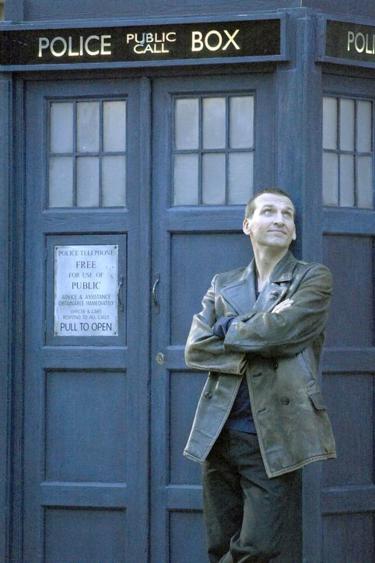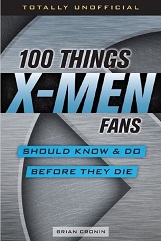Did the BBC Buy the Trademark to Blue Police Boxes From the Metropolitan Police?
Here is the latest in a series of examinations into urban legends about TV and whether they are true or false. Click here to view an archive of the TV urban legends featured so far.
TV URBAN LEGEND: Did the BBC buy the trademark to blue police boxes from the Metropolitan Police?
When the first episode of Doctor Who was written in 1963, one of the biggest points of debate was over what Doctor Who’s time machine would look like. Eventually, they determined that it would look like a police box. Police boxes were little blue concrete rooms that were, in effect, miniature police stations. First created in the United States, they began appearing in the United Kingdom by the turn of the 20th Century. The most iconic blue version of the London police box was introduced in 1929. The police box contained telephones in them that would connect directly with British police stations. This way, police officers would be able to contact their stations whenever they would need to and in addition, through a light at the top of the box, they could be notified when they needed to go to the police box themselves when the station was trying to contact them. In addition, the public could also use the phones to notify the police of crimes (the boxes also carried first aid kits). By the 1950s, London was covered with police boxs, nearly 700 of them dotted the streets. Therefore, if you wanted your time machine to fit in in London in 1963, disguising it as a police box would be a great idea. The police box is revealed in the series to actually be a TARDIS (Time and Relative Dimension in Space), which is exponentially bigger once you enter than what it appears like on the outside. It is simply camouflaged as a police box so as to be able to blend in. However, in the first episode, the camouflaging technology malfunctions, leaving the TARDIS stuck in the form a police box. There was some debate over possibly having the TARDIS disguise itself as different objects as the series went along, but for whatever reason (almost assuredly reasons of cost, but I don’t know that for a 100% certainty) they decided to stick with it just being a police box. Legend has it that the very first Doctor Who TARDIS was a re-used prop from the popular British police television drama Dixon of Dock Green (which was, in turn, based on the 1950 British police film, The Blue Lamp), where Jack Warner played Police Constable George Dixon for decades. This is not true (wow, two legends debunked for the price of one! Lucky readers!). Production designer Peter Brachacki built the police box used in the first episode of Doctor Who (which was then used for the first thirteen seasons of the show).
Anyhow, another legend about the TARDIS is about who owns the trademark to the TARDIS. A common bit of Doctor Who trivia is the following (I got it from this Doctor Who site, but I’ve seen it in plenty of places):
The BBC actually owns the copyright to the design of the Police Box used as the design for the TARDIS. It was bought from the Metropolitan Police.
Besides using the term “copyright” when they mean “trademark” (a common mistake and not one worth making a fuss about), the first part of the trivia is correct. However, how the BBC got the trademark is a lot more complicated than that! Read on to learn how they got it!
In 1994, England revamped their trademark law with the passing of the Trade Marks Act 1994. Soon after the passing of the law, the British Broadcasting Company (BBC), owners of Doctor Who, registered the blue police box as a trademark, for use on pretty much every commercial avenue that you could think of (TV series, toys, shirts, posters, you name it). This simply means that if a T-Shirt or a poster had a picture of a blue police box on it, said product was made by the BBC.

However, instead of going along with the BBC’s efforts, the Metropolitan Police actually specifically filed an opposition claim in 1998 to the BBC’s trademark claim. They argued that the blue police box (known commonly as the “Police Telephone Box”) was a trademark of the Metropolitan Police, not the BBC. They argued that the object was most commonly associated with British police and that they gave consent decades earlier for the BBC to use the box in Doctor Who but they never intended to give up their rights to the trademark of the item.
The Metropolitan Police’s problem, though, was that by 1998, the police box was no longer the ubiquitous sight that it once was in London during the 1950s and 1960s. The advent of compact communication devices in the late 1960s (first walkie talkies and by now, mobile phones) made the boxes mostly superfluous. From nearly 700 boxes in the 1950s, the Police had under 100 by the end of the 1990s and today has fewer than 30 of the boxes. Compare that with the fact that Doctor Who is popular not only in London but all over the world. Therefore, the box was now far more associated as being the TARDIS than being a little-used police box.
Moreover, even if the Police could prove that the public associated the box with them, it would only be an association for actual police work. That is not something, then, that they would expect to see on T-Shirts, posters and toys. The TARDIS, however, is a different story. Finally, the fact that the Metropolitan Police did not actually create the look for the police box was also a knock on them (as noted earlier, the police box originated in the United States).
In the end, the Patent Office ruled against the Metropolitan Police and actually fined them a little over eight hundred pounds and made them pay the BBC’s legal costs. So the blue police box is now all the BBC’s!
The legend is…
STATUS: False as Presented
Here is a link to the 2002 decision if you’r interested in reading it in full.
Feel free (heck, I implore you!) to write in with your suggestions for future installments! My e-mail address is bcronin@legendsrevealed.com.







Of course, there is a major inconsistancy between “The Blue Lamp” and “Dixon of Dock Green” that another British Time Travel series “Ashes to Ashes” makes use of.
[…] blue Police box was introduced in the thirties and contained telephones which were connected with British police stations. In the British TV programme Doctor Who, the blue Police box is a time machine and spacecraft, the […]
[…] Still, the ol’ TARDIS is no stranger (I can say that, it’s alive you know) to the world of legal conflict. After the BBC trademarked the image and representation of the police box, the Metropolitan Police sued — and it didn’t go well for them. […]
1) The “chameleon circuit” giving the Tardis its police box appearance did, in fact, in some of the classic episodes, further malfunction and took on different appearances, such as an organ and a sort of a kitchen cupboard.
2) Isn’t there currently a legal issue not over the ownership of the blue police box image, but over the Tardis itself? Hasn’t the person who created the Tardis (as the police box) claimed continued ownership and the legal dispute with the BBC is ongoing?
Whether the “design” of the TARDIS exterior should be copyrighted, trademarked, or patented is not black and white. The plans themselves would be copyright. The idea would be patent. The use as a recognized symbol would be trademark. The distinction is important, of course, because (at least in the US) trademarks must be defended or the owner risks losing it. Such does not apply to the other 2 types of limited monopoly, despite widespread misconception that they also must be defended to remain durable.